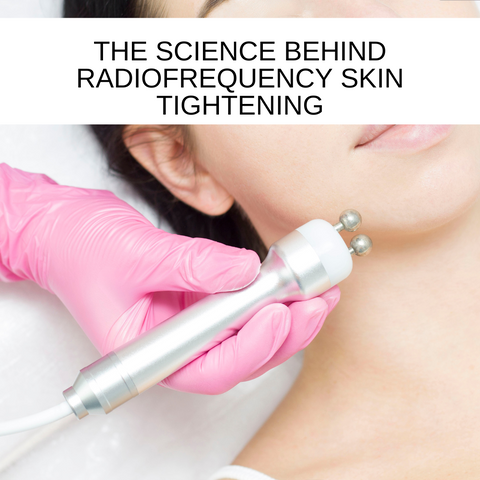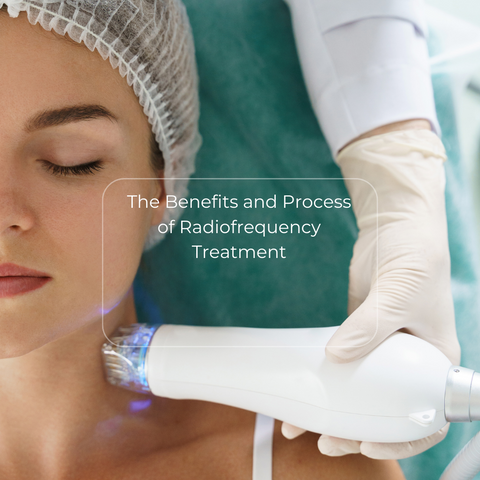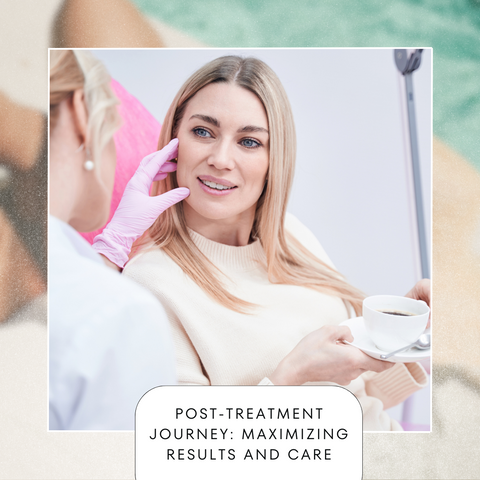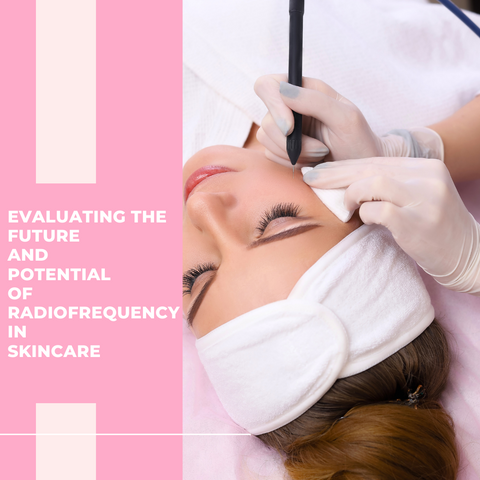Radiofrequency (RF) skin tightening is a non-invasive cosmetic procedure that stimulates collagen formation with radiofrequency energy, resulting in firmer and tighter skin. This blog will cover everything you need to know about this novel treatment.
The Science Behind Radiofrequency Skin Tightening

Radiofrequency (RF) skin tightening employs radiofrequency radiation principles to produce structural changes in the skin, especially targeting collagen and elastin fibres. Radiofrequency energy, collagen, and elastin in the skin, heating mechanisms, stimulation of collagen production, tissue contraction, controlled depth of penetration, neocollagenesis and fibroblast proliferation, gradual results, types of radiofrequency devices, and safety considerations are all part of the science behind RF skin tightening. Understanding the science underlying RF skin tightening allows people to make more informed judgements regarding this non-invasive cosmetic surgery and its possible skin rejuvenation advantages.
How Radiofrequency Technology Transforms Skin
Radiofrequency (RF) technology causes thermal remodelling of the skin, which has a number of therapeutic effects. Here's how RF technology works and the skin changes it causes, such as collagen remodelling, tissue tightening, improved elasticity, wrinkle reduction, increased blood circulation, cellulite reduction, non-invasive skin lifting, acne scar improvement, improved absorption of topical products, customised treatment depths, minimal downtime, and long-term results. This therapy has several advantages, including skin tightening, enhanced elasticity, wrinkle reduction, and overall rejuvenation. RF treatments are a popular option for anyone looking for effective and convenient skin enhancement due to their non-invasive nature and versatility.
Collagen and Elastin: The Building Blocks Enhanced by RF Therapy
Collagen and elastin are proteins found in the extracellular matrix of the skin that provide structural support, elasticity, and resilience. Through its impact on fibroblasts and the collagen remodelling process, radiofrequency (RF) therapy improves these building blocks:
-
Collagen: Collagen is the most prevalent protein in the human body and is an important structural component of skin, tendons, ligaments, and other connective tissues. The skin contains many forms of collagen, with Type I collagen being the most common and important for skin strength and stiffness.
How RF Therapy Enhances Collagen:
-
Fibroblast Activation: Radiofrequency (RF) therapy generates controlled heat in the targeted tissues. In response to the heat, fibroblasts, the cells responsible for collagen synthesis, become activated.
-
Neocollagenesis: Activated fibroblasts initiate neocollagenesis, which results in the formation of new collagen fibres. This procedure helps with skin remodelling and restructuring.
-
Increased Collagen Density: RF therapy improves skin texture, firmness, and reduces fine lines and wrinkles by increasing the density and organisation of collagen fibres in the dermal layer.
2. Elastin: Elastin is another key protein that gives the skin elasticity and flexibility. It enables the skin to stretch and return to its natural shape.
How RF Therapy Enhances Elastin:
-
Elastin Production Stimulation: Like collagen, RF therapy stimulates fibroblasts to produce more elastin fibres.
-
Increased Elastin Production: Increased elastin production contributes to improved skin elasticity, reducing sagging and promoting a more youthful appearance.
-
Enhanced Tissue Resilience: Elastin fibres contribute to a smoother, more lifted complexion by preserving the skin's suppleness and resilience.
RF therapy contributes to skin tightening, increased elasticity, and a younger and brighter complexion by encouraging the production of these necessary proteins. Because RF treatments are non-invasive, they are a popular option for people looking for effective skin rejuvenation without the need for surgery.
Comparing RF with Other Skin Tightening Methods
Radiofrequency (RF) therapy is one of several skin-tightening methods available, each with its own set of mechanics and advantages. Here is a comparison of radiofrequency (RF) therapy to other common skin tightening methods, such as ultrasound skin tightening, laser skin tightening, microfocused ultrasound (MFU), cryolipolysis (coolsculpting), thread lifts, and surgical facelifts.
Considerations for Choosing a Method:
-
Treatment Objectives: The method chosen is determined by the specific skin concerns and the level of improvement desired.
-
Tolerance for Downtime: People who have a low threshold for downtime might favour non-invasive techniques like radiofrequency or ultrasound.
-
Treatment Area: Different methods may be more appropriate for specific areas of the body, such as the face, neck, or body.
Personal preferences, treatment goals, and criteria such as downtime tolerance all influence the choice between RF therapy and other skin tightening techniques. Consulting with a knowledgeable skincare professional can help you determine the best approach for attaining your goals.
The Benefits and Process of Radiofrequency Treatment

The Benefits of Radiofrequency (RF) Treatment:
-
Skin Tightening: RF therapy increases collagen production, which results in tighter, firmer skin. It works well for treating mild to severe skin laxity.
-
Wrinkle Reduction: RF therapy reduces fine lines and wrinkles by encouraging collagen remodelling. Skin texture improvement adds to a smoother appearance.
-
Improved Elasticity: Elastin synthesis is increased, which enhances skin elasticity and reduces sagging. The skin becomes more resilient and has a more youthful bounce.
-
Non-Invasive: Because RF treatment is non-invasive, it is a popular choice for people looking for skin tightening without surgery. It causes little discomfort and usually requires no downtime.
-
Versatility: RF therapy can be applied to a variety of body parts, including the face, neck, abdomen, thighs, and buttocks. It can be used to treat a variety of skin issues.
-
Gradual Results: While some immediate tightening is noticeable, optimal results take several weeks to months to manifest. This gradual improvement can result in natural-looking results.
-
Collagen Boost: RF therapy promotes neocollagenesis, which leads to increased collagen density. The collagen boost improves the overall quality and structure of the skin.
-
Minimal Discomfort: RF treatments are usually relatively painless for patients. Some devices include cooling mechanisms to improve comfort.
-
Quick Sessions: Treatment sessions are usually between 30 minutes and an hour long. Individuals with hectic schedules will appreciate the convenience of quick sessions.
-
Safe for Various Skin Types: In general, RF therapy is safe for all skin types and tones. It is a versatile option that can be tailored to meet the needs of each individual.
The Radiofrequency Treatment Process:
-
Consultation: A skincare specialist consults with the patient to analyse the patient's skin condition, complaints, and suitability for RF treatment. The practitioner goes over the expected results and answers any questions.
-
Preparation: The treatment area is cleansed, and a cooling gel may be used to increase RF device glide and patient comfort.
-
Application of RF Device: The RF device is attached to the desired location, and radiofrequency radiation is given to the skin under control. Depending on the therapy aims, the device may have multiple settings to customise the depth of penetration.
-
Sensation During Treatment: Patients may experience a warming feeling as the RF radiation is administered, but pain is usually minor. Cooling systems, if present, improve comfort even more.
-
Treatment Duration: The length of a session is determined by the size of the treated area and the device employed. Sessions usually last 30 minutes to an hour.
-
Post-Treatment Care: After RF therapy, there is usually little to no downtime. Patients can promptly resume normal activity.
-
Results and Maintenance: Initial benefits are obvious, including some instant tightness. A series of sessions is required to attain optimal and long-term outcomes. Maintenance sessions may be advised to extend the results.
-
Combination with Other Treatments: For improved results, RF therapy can be coupled with other cosmetic procedures. Combining therapies has the potential to address many facets of skin rejuvenation.
-
Follow-up Consultations: Patients may be scheduled for follow-up meetings to assess progress and determine whether additional sessions are required. The skincare specialist may make recommendations for ongoing skincare.
-
Patient Education: To optimise and sustain outcomes, patients are trained on post-treatment maintenance, including sun protection and skincare practises.
To ensure safety, effectiveness, and personalised care based on specific skin traits and problems, choose a competent skincare professional or consult a dermatologist for RF treatments.
Key Advantages of Choosing Radiofrequency for Skin Firming
Using radiofrequency (RF) for skin tightening has numerous major advantages, making it a popular choice for people looking for non-invasive and effective skin tightening options. Here are some of the primary Advantages:
-
Non-Invasive Nature: RF treatments are generally well tolerated and cause little discomfort. Patients may feel a warming feeling during the operation, but it is usually not uncomfortable. RF therapy, unlike surgical facelifts or other invasive procedures, does not require incisions, which reduces the risk of scarring and infection.
-
Versatility and Targeted Treatment: RF therapy is adaptable and can be used on a variety of body parts, including the face, neck, abdomen, thighs, and buttocks. Adjustable settings enable practitioners to tailor the level of energy penetration to individual needs, targeting specific layers of the skin.
-
Minimal Downtime: Patients can usually resume normal activities soon following RF treatment. Unlike surgical methods, there is no need for a lengthy recuperation period, making RF an appealing alternative for those who lead hectic lives.
-
Stimulates Collagen Production: RF therapy increases collagen formation, resulting in enhanced collagen density and improved skin structure. The progressive increase in collagen levels leads to the natural-looking effects that emerge over time.
-
Reduced Fine Lines and Wrinkles: RF therapy reduces fine lines and wrinkles by encouraging collagen remodelling. The therapy improves skin texture and reduces the appearance of age-related wrinkles.
-
Improved Skin Elasticity: Improved skin elasticity is aided by increased elastin synthesis. The skin becomes more resilient, which reduces sagging and promotes a more lifted appearance.
-
Safe for Various Skin Types: RF therapy is generally safe and effective for people with different skin types and tones. RF, unlike some laser treatments, is less prone to induce pigmentation problems, making it appropriate for people with darker skin tones.
-
Gradual and Long-Lasting Results: While there is some rapid tightness, the full effects of RF treatment take weeks to months to manifest. The results can be long-lasting with adequate maintenance, offering continued skin firming effects.
-
Complementary to Other Treatments: For a more thorough rejuvenation approach, combine RF therapy with additional cosmetic procedures such as laser treatments or dermal fillers. By combining treatments, practitioners can address many elements of skin ageing at the same time.
-
Cost-Effective Alternative: RF therapy is frequently less expensive than surgical procedures, making it more accessible to a wider range of people. RF therapy is a good investment because it is non-invasive and has the potential for long-term results.
Using radiofrequency for skin firming is a smart choice for those who value non-invasiveness, little downtime, and a natural-looking improvement in skin tightness and texture. As with any cosmetic procedure, consulting with a skilled skincare specialist to select the best treatment plan based on individual needs and goals is vital.
What to Expect During a Radiofrequency Procedure
Radiofrequency (RF) therapy for skin tightening normally consists of many phases. Here's what to expect during an RF therapy session in general:
-
Initial Consultation: You will have an initial consultation with a skincare professional or dermatologist before the procedure. Your skin condition, concerns, and medical history will be evaluated during this session. The practitioner will talk with you about your goals, explain the RF technique, and answer any questions or concerns you may have.
-
Preparation: The treatment region will be cleaned on the day of the operation to remove any makeup, oils, or lotions. The skin can be soothed using a cooling gel. This gel improves patient comfort by improving contact between the RF device and the skin.
-
Application of RF Device: The practitioner will employ a radiofrequency (RF) equipment that emits regulated radiofrequency energy. The gadget may have many settings that allow you to tailor the depth and intensity of the treatment to your unique needs. The gadget will be applied to the desired location by the practitioner, delivering RF energy to the skin.
-
Sensation During Treatment: You may feel a warming feeling on your skin while the RF radiation is delivered. Some RF devices have cooling systems to improve patient comfort and reduce discomfort.
-
Adjustments and Monitoring: The practitioner will monitor your skin's reaction to the RF energy and make modifications as needed. The goal is to achieve the optimal level of heat for collagen stimulation while minimising discomfort and side effects.
-
Treatment Duration: The length of the RF therapy session depends on the size of the treated region and the device employed. Treatment sessions usually last 30 minutes to an hour.
-
Post-Treatment Care: There is usually little to no downtime after the RF therapy. You can continue your normal activities right away, and there is usually no requirement for recovery time. It is, however, important to follow any post-treatment guidelines given by the practitioner, such as avoiding excessive sun exposure and using sunscreen.
-
Immediate and Gradual Results: Due to the constriction of existing collagen fibres, some skin tightening may be apparent immediately after treatment. However, the full effects of RF treatment, such as enhanced collagen formation and skin firming, will take weeks to months to manifest.
-
Number of Sessions: The number of recommended sessions varies according to individual goals, skin condition, and the type of RF equipment used. A series of treatments is frequently suggested for optimal and long-term outcomes.
-
Follow-Up Consultations: Depending on the treatment plan, you may be required to attend follow-up meetings to assess progress and determine whether more sessions are required. The practitioner might make suggestions for continued skincare and maintenance.
-
Combination with Other Treatments: RF treatments may be combined with other cosmetic procedures in some circumstances to address several elements of skin rejuvenation. Based on your concerns, the practitioner will explain the potential benefits of combining therapies.
-
Patient Education: The practitioner will provide instructions on post-treatment care, including skincare practises, both before and after the procedure.
Choosing a qualified and experienced skincare professional for RF treatments is essential to ensuring safety, effectiveness, and personalized care tailored to your skin characteristics and concerns.
Customizing Treatments for Optimal Skin Rejuvenation
Because each person's skin is different and various factors influence the ageing process, tailoring skin rejuvenation therapies is essential for achieving the greatest results. Comprehensive skin assessment, tailored treatment plans, addressing specific concerns, customizable intensity levels, skin type considerations, a gradual and progressive approach, post-treatment care, patient education, assessing patient preferences, and a long-term maintenance plan are some essential factors for tailoring therapies to specific skin issues and maximising rejuvenation. Skincare specialists can optimise outcomes and deliver a personalised experience for their clients by personalising treatments, altering intensity levels, and taking into account aspects such as skin type and preferences. Regular contact and follow-up assessments are required for continuous treatment plan modification and refining.
Post-Treatment Journey: Maximizing Results and Care

Following skin rejuvenation treatments, the post-treatment journey is critical to maximising outcomes and maintaining skin health and beauty. Here's an overview of post-treatment care and strategies for improving outcomes:
-
Immediate Post-Treatment Care: Follow any post-treatment instructions given to you by your skincare specialist. Avoid sun exposure soon after therapy and, if necessary, wear sun protection.
-
Skincare Regimen: To clean the treated area without causing irritation, use a gentle cleaner. To keep the skin hydrated, use a moisturising and soothing moisturiser. Avoid strong or abrasive skincare products that may cause skin irritation.
-
Sun Protection: Even on cloudy days, use a broad-spectrum sunscreen with an SPF of 30 or higher. Reapply sunscreen every two hours, or sooner if swimming or sweating.
-
Hydration: Drink enough of water to stay hydrated and support skin health from the inside out.
-
Avoiding Irritants: Tobacco use can impair the skin's capacity to heal and contribute to accelerated ageing. Alcohol can dry the skin if consumed in excess, therefore moderation is essential.
-
Gentle Skincare Products: Choose skincare products that are soft and relaxing, especially in the immediate post-treatment time. Avoid using harsh or active substances until the skin has completely healed.
-
Gradual Resumption of Activities: Resuming physical activity gradually, as directed by your skincare professional. In the first few days after therapy, avoid hot baths, saunas, and activities that may induce excessive perspiration.
-
Follow-Up Appointments: Keep all follow-up appointments with your skincare professional. During follow-up sessions, you can discuss the progress of your skin and resolve any concerns.
-
Long-Term Maintenance: Create and stick to a skincare routine that is personalised to your skin's needs. Consider frequent maintenance treatments or touch-ups, as recommended by your skincare professional.
-
Lifestyle Adjustments: Maintain a balanced and nutritious diet rich in vitamins and antioxidants to support skin health. Ensure sufficient sleep to promote overall well-being and skin recovery.
-
Patience and Realistic Expectations: Understand that skin rejuvenation is a gradual process, and full results may take time to manifest. Have realistic expectations and communicate openly with your skincare professional about your goals.
-
Addressing Concerns Promptly: If you notice any unexpected changes or have concerns about your skin, communicate with your skincare professional promptly. Early intervention can help address issues before they become more challenging to manage.
-
Sun Avoidance and Protection: If possible, avoid being outdoors during peak sun hours when the sun's rays are most intense. Consider wearing protective clothing, such as hats and sunglasses, for additional sun protection.
-
Consistent Use of Skincare Products: Use any topical treatments given by your skincare professional on a regular basis for continued maintenance.
-
Emotional Well-being: Stress can have an effect on skin health, so incorporate self-care practises to control it. Maintain an optimistic attitude about your skin rejuvenation journey's progress.
Individuals can maximise the advantages of their treatments and improve long-term skin health by following a thorough care plan that includes good skincare, sun protection, and a healthy lifestyle. Regular communication with a skincare specialist ensures continuing assistance and, if needed, changes to the care plan.
Effective Aftercare for Radiofrequency Treatments
Aftercare for radiofrequency (RF) treatments is critical for optimising results, minimising potential adverse effects, and promoting skin healing. Immediate post-treatment care, skincare products, sun protection, hydration, avoiding irritants, cooling measures, makeup use, physical activities, follow-up appointments, scheduled check-ups, gradual resumption of skincare routine, sun avoidance and protection (long-term), patient education, consistent skincare routine, emotional well-being, and long-term sun protection are all part of an effective aftercare routine for individuals who have undergone RF treatments. By adhering to these principles and communicating with your skincare professional, you can optimise the outcomes of your RF treatments and maintain healthy, glowing skin in the long run.
Long-Term Maintenance of Skin Tightening Results
Maintaining the results of skin tightening treatments necessitates a long-term commitment to a skincare routine, lifestyle changes, and maintenance sessions. Consistent skincare routine, sun protection, hydration and nutrition, healthy lifestyle, skincare professional guidance, maintaining a stable weight, staying hydrated, retinoids and exfoliation, regular professional treatments, managing stress, quality sleep, body contouring and exercise, self-monitoring, patience and realistic expectations, and collagen-boosting nutrients are some tips to help you preserve and enhance the long-term benefits of skin tightening. Individuals can achieve long-term benefits in skin tightness and general skin health by following a consistent and comprehensive practise. Collaboration with skincare professionals on a regular basis ensures that your skincare strategy remains adapted to your changing needs.
Incorporating RF Treatments into Your Skincare Regimen
Incorporating radiofrequency (RF) treatments into your skincare regimen necessitates careful planning and understanding of your skin's specific requirements. Consultation with a skincare professional, development of a customised treatment plan, pre-treatment preparation, treatment day skincare, post-treatment skincare, sun protection, hydration, and cooling measures, gradual resumption of skincare routine, regular follow-up appointments, long-term maintenance, lifestyle adjustments, combined with other treatments, educating yourself, and being patient You may effortlessly include RF treatments into your skincare regimen by following a customised plan designed with the help of a skincare specialist, ensuring that your routine supports the effectiveness of the treatments and promotes overall skin health. Communication with your skincare specialist on a regular basis is essential for changing your skincare strategy as your skin's needs change.
Evaluating the Future and Potential of Radiofrequency in Skincare

The future and potential of radiofrequency (RF) in skincare hold tremendous prospects as technology progresses and researchers continue to explore creative applications. Advances in technology, enhanced treatment modalities, expanded applications, side effect minimization, deeper tissue penetration, personalised skincare plans, accessibility and affordability, clinical research and evidence, patient education and awareness, and ethical and inclusive practises are some factors to consider when assessing the future of RF in skincare. As technology advances, continuing collaboration among skincare practitioners, researchers, and industry stakeholders will be critical in creating the future landscape of RF in skincare. Patients and consumers, in turn, stand to benefit from a varied range of skincare choices suited to their specific needs and preferences.
Emerging Trends in Radiofrequency and Skincare
These findings point to a fluid landscape for the incorporation of radiofrequency technologies into skincare practises. As technology advances, more improvements in the skincare business are anticipated, making RF treatments more adaptable, personalised, and accessible to a wider spectrum of people. Remember that staying up to date on the newest advances and consulting with skincare professionals are critical for making well-informed decisions about skincare treatments.
Dermatological Perspectives on Radiofrequency Efficacy
Dermatologists play a crucial role in assessing and providing perspectives on the efficacy of radiofrequency (RF) in various skincare applications. Here are dermatological perspectives on RF efficacy such as collagen stimulation, skin tightening, non-invasive nature, safety profile, versatility, minimal downtime, combination therapies, long-term results, patient selection, adaptable energy settings, treatment areas, research and evidence, patient education, ethical practices and future developments. Their perspectives, grounded in scientific knowledge and clinical experience, guide patients in making informed decisions about incorporating RF treatments into their skincare regimens. Ongoing collaboration between dermatologists and researchers is essential for advancing the field and optimising the benefits of RF in dermatology.
Advancing Beyond Traditional Skin Tightening Approaches
Advances in skincare are constantly pushing the limits of traditional skin tightening methods. These cutting-edge treatments and technologies provide novel alternatives for anyone looking for effective, personalised, and minimally invasive skin rejuvenation and tightening options. Continuous research, clinical studies, and collaboration between skincare specialists and technology developers will refine and increase the capabilities of these sophisticated treatments as the sector evolves.
















